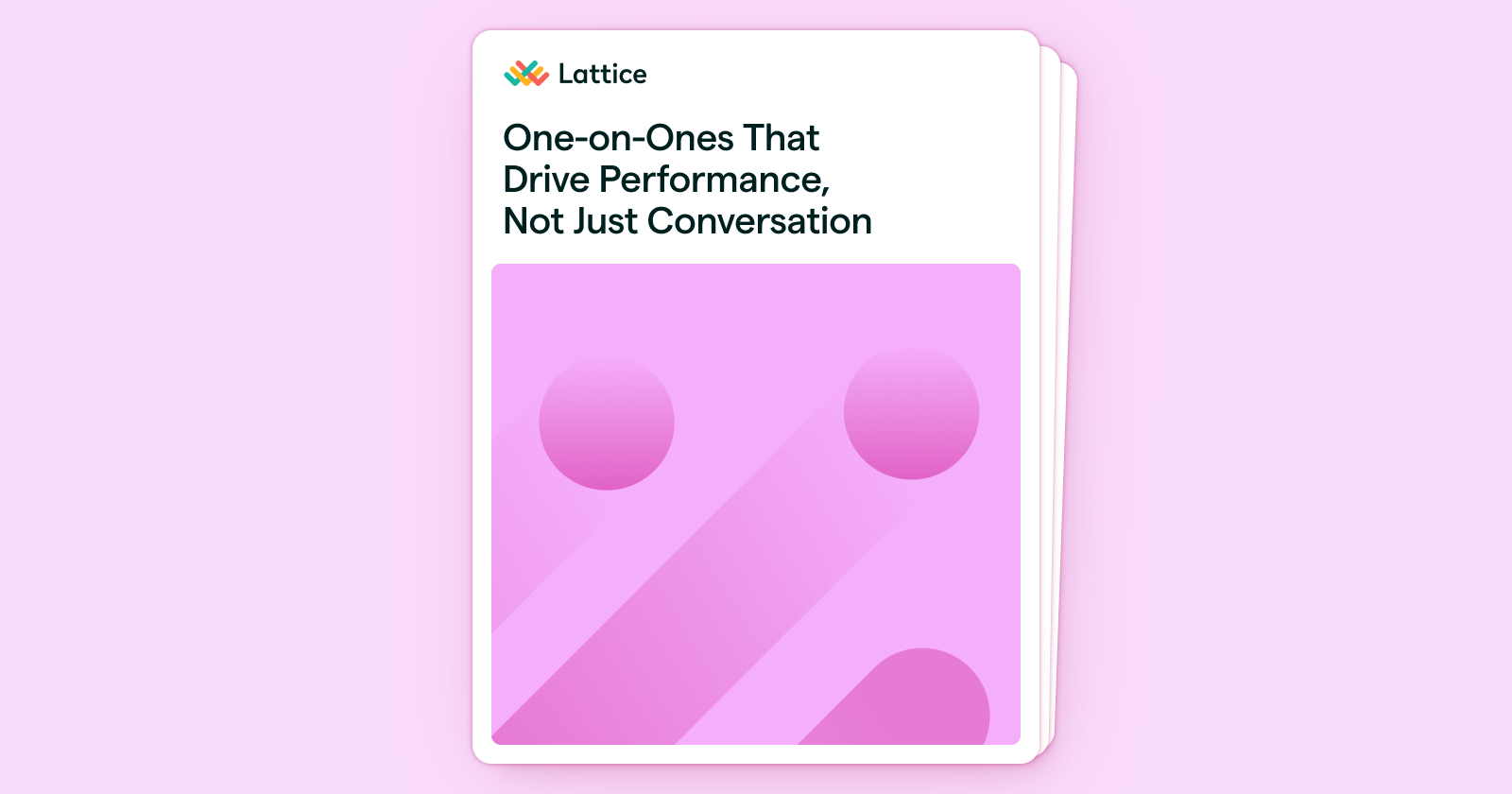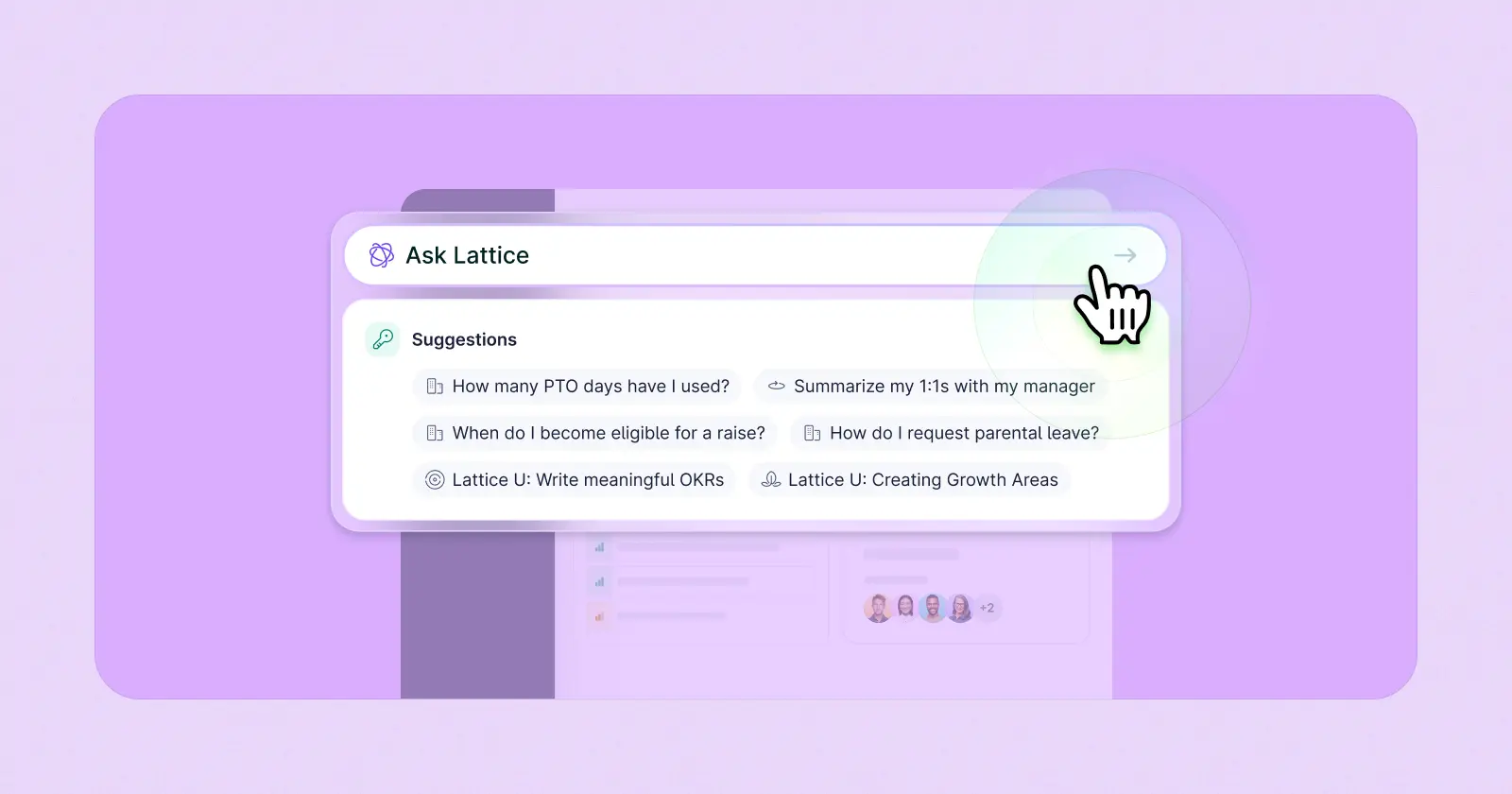2026 is HR’s year for leading with purpose.
Across tech, performance, community, and culture, leaders will be focusing on building more intentional processes, decisions, and connections that hold trust and transparency at their core.
They’ll be tuning in to what it means to be responsible in AI adoption, supporting culture through continued political upheaval, building relationships that cement new HR practices, and helping managers find stability by creating systems that work.
Here are the six key HR trends that we think will shape HR strategy for the year ahead.
1. AI governance, not just adoption, becomes a key compliance issue for HR.
2025 was the year that human resources got real about artificial intelligence. The excitement of a brave new world of work has given way to trepidation as HR leaders grapple with the ethical reality of AI-driven tooling within the HR function — and the organization-wide implications that come with it.
A massive 61% of HR professionals in our 2026 State of People Strategy Report flagged ethical concerns with adopting AI. And as laws continue to evolve to regulate its use in hiring, HR leaders are on the hook for ensuring the organization stays compliant.
“We’ve already seen a slow-moving trend of CHRO/CPO and CIO roles merging, giving HR formal ownership of an organization’s AI strategy,” said Siobhan Brunwin, founder of Blossom HR Consulting.
“But the majority of companies have very little in place in terms of formal governance. There is very little in employment law about AI. There will be more and more demand on HR teams to become the ethical checkpoint. HR has to develop a point of view on AI without a legal framework to rely on — and quickly.”
Building the Foundations of Responsible AI Governance
For many HR teams, the most important first step with AI governance is setting out what “responsible” use looks like. Before plunging into experimenting with new tools, ask:
- How will we implement AI across key touchpoints in the employee lifecycle, such as talent management, onboarding, and workforce management?
- Where are our strongest use cases for AI?
- Where should AI assist in decision-making — and where shouldn’t it?
- Who is responsible for overseeing AI-powered tooling within HR?
Noelle London, founder and CEO of employee data platform Illoominus, said that the deeper governance groundwork is as much operational as it is conceptual.
“Everybody wants to see what the predictive model can tell them, but their data isn’t ready for it,” she said. “Ninety percent of the work is getting your data in the proper format and with the proper foundation. Ten percent is the output you're seeing in a predictive model.
“If there isn’t proper governance across access levels, AI could potentially expose sensitive information to people who shouldn't have it,” she added. “Governance starts with knowing the questions to ask about your AI solutions and asking them early — especially around data access, privacy, and how the model uses sensitive information.”
HR teams can get ahead on AI governance by:
- Evaluating how HR practices align with evolving local and global laws, such as the EU AI Act or California’s AI Safety Law, for example
- Identifying your biggest data privacy and security risk factors when implementing AI in HR
- Being transparent with employees about how and where the HR function will use AI in key workflows to protect trust and the employee experience
- Evaluating HR technology vendors on their data security and compliance standards, including:
- How does the tool use and store employee data?
- How transparent is the tool’s decision-making process? Can we clearly trace the reasoning behind each decision?
- Who can see, use, and export data? How do we control access?
- What happens to our data if we move to another vendor?
{{rich-highlight-3}}
2. Performance management is top of the agenda — but high engagement will sustain it for winning teams.
2026 marked the first year that performance edged out engagement as HR’s top priority in our report. Statistically speaking, the win was minuscule — but it highlighted that maintaining peak performance is less about pushing people harder, and more about engaging them so teams can reap the benefits of both.
“Employee engagement can be a distraction when we treat it as a separate program,” said Kim Minnick, founder and principal consultant of Code Traveller HR. “We tend to think of it as a survey–action planning–execution cycle, when really it’s the result of so many of our other programs. When you get everything else right, engagement is the outcome — because engagement is performance.”
Designing Performance Systems That Drive Engagement
For HR teams, leaning into the symbiotic relationship between performance and engagement relies on creating clear, consistent, and equitable systems where each can reinforce the other.
It’s all in the fundamentals that nurture a sense of growth, goal achievement, and fair reward.
“If you have a great performance program that sets clear expectations, creates focused goals and manageable priorities, offers predictable, equitable growth paths, and where employees understand rewards and recognition, you’re on a great path to engagement,” Minnick noted. “This is reinforced in an organization that makes its values clear and consistently displays them.”
According to Minnick, HR leaders can nurture performance and engagement in 2026 by:
- Creating meaningful recognition programs that outline exactly how compensation and progression work, as well as clear criteria for achieving bonuses or non-financial rewards
- Building a company culture of recognition that celebrates achievements at the team and company level
- Making sure all employees have a clear idea of what’s expected of them at every role and level
- Creating structured, individualized growth paths and equitable opportunities for upskilling and reskilling, alongside the developmental resources and support to do so
- Building a culture that prioritizes openness and transparency through feedback mechanisms like employee surveys and manager one-on-ones
- Fostering the conditions that enable employee wellbeing and work-life balance
3. HR leaders seek community outside of traditional institutions.
HR people are definitely people people. But many are starting to think much more deeply about exactly which people they hang out with professionally.
Professional HR memberships are dwindling, with less than a third (32%) of Gen Z HR professionals affiliated with an HR association, compared to 43% of their millennial peers.

And as some long-standing professional institutions have faced intense criticism and boycotts in recent years, many leaders are questioning whether their old clubhouse membership still holds value.
“I don’t think we throw out communities of practice, because they still matter. They keep us grounded in what’s required: legal, ethical, and operational stuff that really does need consistency,” said Nicole Eisdorfer, PhD, founder and principal of HR consultancy Truer Words.
“But they’re not where new ideas or better ways of working are going to come from anymore. The next chapter of HR isn’t about proving you know the rules — it’s being willing to embrace that common practice doesn’t necessarily equal best practice for our organization.”
Reimagining Connection and Learning for HR
Finding your tribe in 2026 might look a little different from times past. But it’s more of a strategic shift than just switching sides.
“Traditional associations taught us to memorize and comply; strategic HR requires us to discern and adapt,” Eisdorfer said. “Influence won’t come from standardized credentials but from the credibility you build by thinking out loud, testing assumptions, and earning trust through how you navigate complexity.”
Communities of trust will be where it’s at for HR, said Eisdorfer: “It’s the group chat or Slack channel where people talk about what actually happened — the experiments, the stumbles, the messy middle — without worrying about being ‘off-brand.’
“It’s not about building another big association,” she added. “It’s about linking the small, high-trust circles that already exist so HR pros can find each other faster — people who challenge you, not just validate you.”
In 2026, HR leaders can find their community by:
- Joining online communities like Reddit and Slack to build connections. Eisdorfer recommends Lattice’s Resources for Humans, Open Org, HR Summer School, and Fractional People People.
- Signing up for peer, reverse, or co-mentoring opportunities, to share knowledge and develop skills
- Reevaluating the value of professional credentials and affiliations within hiring criteria for HR team members
- Hosting or joining roundtables and local events focused on sharing ideas — such as DisruptHR
4. Polarization and regulatory thrash reach critical mass.
By now, it’s pretty obvious that employees never truly left their personal lives at the office door — decades of water cooler gossip can account for that.
But in the last couple of years, their politics have increasingly begun to cross the threshold, too. And as political clashes, shifting workplace values, and an evolving legal environment continue to ratchet up the tension, 2026 could be HR’s year to get off the fence.
“2026 will be the moral crossroads year,” explained Charmaine Green-Forde, founder and CEO of HR consulting and coaching company, Chapter tOO. “We’re in a global trust recession. Institutions, media, and leadership have lost credibility, so employees are looking to their employers for truth and stability.
“Employees may not jump ship immediately, but they’re taking notes, disconnecting quietly, and waiting for the first chance to move toward organizations that take a stand on something,” she added. “I truly believe that in 2026, HR and organizations will be assessed through the lens of values alignment in a way they’ve never experienced before, and by how their actions measure up to their words.”
Leading Through Polarization With Integrity
In an era when stating a political opinion can get you fired, employees are reevaluating who they work for based on what they stand for. It’s HR’s job to navigate those roiling tensions — and conflicting opinions — without sacrificing integrity.
Almost a quarter (23%) of HR professionals reported that navigating cultural and political polarization is becoming a significant problem — making it harder for HR and the organization to stay neutral.
“Neutrality or integrity will be what more HR pros wrestle with most,” noted Green-Forde. “We were taught neutrality, but in what we’re navigating now, even that will be tested. That means silence won’t read as safety anymore, it will read as avoidance or complicity. HR will need to pick a side.”
At an organizational level, “picking a side” means employees and candidates have clarity on what the company stands for. But at the HR level, it’s about standing up for fairness and integrity when it matters most.
“In practice, ‘picking a side’ won’t always mean issuing a public statement,” Green-Forde said. “It will show up in the daily decisions and trade-offs HR and leadership make when values and business pressures collide.”
According to Green-Forde, HR teams can navigate political tension and employee polarization by:
- Setting clear guidelines on what constitutes acceptable political conversations and discussions — and ensuring consistency when values are tested
- Ensuring transparency and honesty around core processes and decisions, including layoffs, social positions, or pay decisions
- Encouraging open dialogue through Slack groups or initiatives like employee resource groups
- Creating safe channels for conflict resolution, including formal complaint processes and anonymous reporting mechanisms
5. Tech consolidation reigns amid tighter budgets.
If there’s one phrase that has loomed larger than any other in 2025, it’s “budget cuts” — and we’re expecting more of the same into 2026.
Over half (55%) of HR professionals are under somewhat or significant pressure to streamline their HR tech stacks as organizations tighten their purse strings in the wake of a turbulent economy.
But the data shows high-performing HR teams have specialized tools for performance management.
Simplifying and Streamlining the HR Tech Stack
With HR tech stacks getting larger and digital overlap becoming the norm, the case of what to cut may not feel straightforward for HR teams — especially when some legacy systems connect to business processes that aren’t easy to switch off.
The easiest place to start, said Minnick, is with what you do need.
“It’s spring cleaning time for HR,” she said. “It’s a case of knowing, ‘Can I throw this out, or will I need it eventually?’ You need to start by identifying your primary, must-have systems. Then, identify your secondary systems — the ones that enable your work and initiatives to be done well, like performance tools. What you’re left with is a group of third-tier tools — those are probably the ones that you can consider removing.”
Optimize your tech stack by:
- Evaluating all tools based on the use case they serve, rather than the features they offer, and what would happen if you cut the tool overnight.
- Identifying how each tool helps HR achieve goals that connect directly to business outcomes — such as driving performance, improving retention, or strengthening workforce planning efforts.
- Assessing how well your tools integrate with one another — especially when it comes to the accuracy of output and data.
- Considering how the overall user experience of a tool impacts its adoption, both within HR and across the organization. If it’s hard to use or a niche use case, it could be worth cutting.
6. Managers spin more plates than ever — and tech could add to the load without oversight.
Managers are critical to every organization’s success. But they’re handling more than ever. Hiring, performance, engagement, and growth: Every manager is simultaneously a mentor, motivator, career coach, and company champion, often without the tools, training, or support to do it well.
In our 2025 State of People Strategy Report, we highlighted that 30% of managers were feeling overwhelmed, with 10% starting to feel burned out. And with a 2025 Business Insider report highlighting that their spans of control are increasing, managers are at a very real risk of getting crushed by the weight of their responsibility.
{{rich-highlight-2}}
Pairing Process and Tech to Ease the Manager Burden
Managers feeling overloaded is nothing new — but it might be getting amplified by inefficient systems, shifting expectations, and an uneven integration of AI-driven tools.
Tech and AI can ease this burden, but part of the challenge is knowing exactly where they fit in.
“Your humanity is your most important asset as a manager,” said Kim Rohrer, founder of HR strategy consultancy Patchwork Portfolio. “If you’re incorporating AI into your workflow, make sure it’s helping clear space for you to create more human connection with the people on your team.
“AI is not a substitute for human cognition — get support on things like optimizing your team's project prioritization, organizing your notes from several related meetings, or automating rote tasks like sending reminder emails...not on things like delivering feedback, making roadmap decisions, or determining promotions.”
But this vision can only be within reach if AI tooling is paired with well-designed processes to begin with. Otherwise, managers just end up babysitting extra tools — and extra work.
When performance management is designed around biannual check-ins with no clear framework on how to give meaningful feedback or set goals, adding AI-generated talking points won’t help solve the problem.
But when performance is focused on monthly check-ins with clear goals and structured feedback loops, and is supported by mechanisms like one-on-ones, layering in AI can help organize meeting notes, find patterns and trends over time, and flag development areas on a continuous basis. The tech becomes a nudge toward better processes, not a crutch.
HR teams can support managers in 2026 by:
- Auditing core manager-led processes end to end, and identifying where there are gaps or roadblocks causing managers to become overburdened
- Involving managers in HR process design and AI tool integration to pressure test how tools work in real-life scenarios
- Segmenting manager survey metrics to keep a pulse on managers’ overall sentiment, attrition risk, and engagement scores
- Redistributing manager workload using AI-enabled tooling such as automation and generative AI, so that AI becomes an effortless assistant, rather than an entirely new way of working
Leaning on Purpose Amid the Pressure in 2026
For leaders, the top HR trends in 2026 will be defined by a constant tug-of-war between multiple high-ticket — and often opposing — priorities. AI governance, political polarization, and budget cuts may leave some teams feeling embattled, defending their people programs with everything they’ve got.
But when everything feels like it’s on fire, HR’s internal sense of purpose and intentionality will be the thing that helps teams stay centered on what matters most. In a year when HR could get stuck putting out little fires everywhere, the teams that succeed will be the ones that know where to focus and what to let go. Connecting people, process, and tech effectively will be essential to this effort — but only when those connections are built with clarity about what the organization and its employees need, and where it’s trying to go.
{{rich-highlight-1}}
Want more intel on what 2026 will bring?
Read our 2026 State of People Strategy Report to discover how other HR leaders are responding to what’s coming — and what they’re going to do about it.
Or, if you’re ready to learn how Lattice can help you meet these challenges head-on, take a self-guided tour of the platform.










